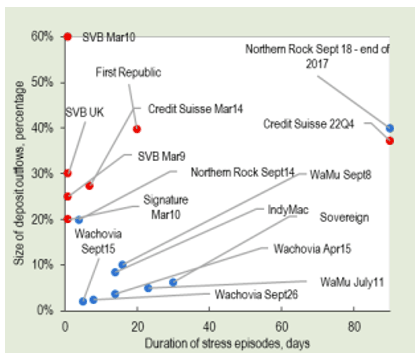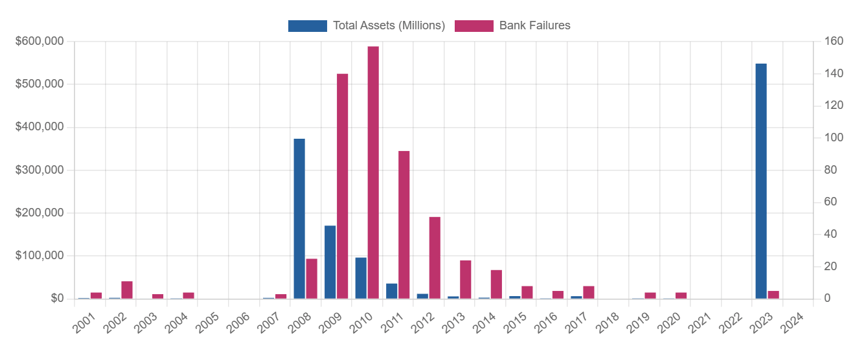
On March 5, nearly a year after the collapse of Silicon Valley Bank, the credit-risk-challenged New York Community Bancorp was causing jitters locally and in financial markets. Deposits had fallen since February 5 by $6 billion, to $77 billion.
Deposits rebounded with the March 7 announcement of a $1 billion equity investment by a group led by Steven Mnuchin, who took a seat on NYCB’s board along with its new CEO, Joseph Otting. Mnuchin was secretary of the Treasury, and his longtime associate Otting headed the U.S. Office of the Comptroller of the Currency, during the Trump administration.
NYCB’s 7% deposit runoff in a month, on top of a $2.7 billion net loss in 2023’s fourth quarter, a stock-price nosedive and dividend cut, was troubling, to be sure. But in the historical scheme of bank runs and failures, and particularly compared to the sudden demise of Silicon Valley Bank, the $116 billion-in-assets NYCB had it easy (at least to this point).
Bank runs, influentially studied and modeled by Douglas Diamond and Philip Dybvig, 2022 Nobel Prize winners with Ben Bernanke, are fundamentally liquidity crises. Those touched off by depositor panic are far less common than they once were, thanks largely to deposit insurance, other regulatory modernization and effective executive (and risk) management.
Acting Comptroller Michael Hsu: “Bank runs are changing.”
When such protections and controls faltered in near unison at sizable regional institutions – SVB and New York’s Signature Bank were closed, respectively, on March 10 and March 12, 2023, and the tottering First Republic Bank of San Francisco was taken over by JPMorgan on May 1 – regulators swooped in with extraordinary measures to prevent contagion that could have threatened the stability of the financial system.
Deposits Predominantly Uninsured
By the numbers, SVB was in a class by itself: It lost $42 billion of its $175 billion in deposits, or 24%, on a single day, March 9. As much as $100 billion more was queued up to flee on the 10th.
Over 90% of the Santa Clara, California-based bank’s deposits were uninsured, that is, not protected under the Federal Deposit Insurance Corp.’s $250,000-per-accountholder ceiling. They were also highly concentrated in the high-tech and venture capital sectors. The funds proved to be “flighty” when word spread through those communities about the bank’s precarious liquidity.
SVB in the end was unable to cope with a flood of withdrawal requests from a close-knit “monoculture” well-connected to the internet, online banking and electronic payment services.

SVB (upper left corner) suffered the biggest and fastest run. Source: IMF.
Twitter and Faster
Chatter on Twitter, now X, was blamed for inciting “the first Twitter-fueled bank run,” in the words of Representative Patrick McHenry, chair of the House Financial Services Committee.
Yale University finance and management professor Andrew Metrick, who is founding program director of the Yale Program on Financial Stability (YPFS) and shares credit for the Metrick-Schmelzing Banking-Crisis Intervention Database, told CNN Business on March 14, 2023: “Even back in the ancient days, way before we had any form of modern communication, this stuff tended to be rumors that moved really fast. The reason it would happen is people would walk down the street and observe people standing outside of banks. Now we don’t have that, but we have Twitter.”
YPFS associate director of research Steven Kelly offered a modified scenario this February in FT Alphaville. Rather than over Twitter, which is a retail phenomenon, conversations more plausibly took place in private group chats among sophisticated investors who “aren’t pulling hundreds of millions via digital app” – if that were even possible or practical.
YPFS’s Steven Kelly: Get the analyses right.
“Let’s get the first-order macro and balance sheet analyses right,” Kelly asserted. “Just because we can watch modern bank crises on Twitter, doesn’t mean that’s where they happen.”
Modern runs revolve more around institutional money management – as with Circle Internet Financial’s $3.3 billion held at SVB – than individuals lining up outside bank front entrances, Kelly explained in a March 11 Yahoo Finance Live interview.
Technology is nonetheless accelerating banking; its risk and regulatory guardrails, not so much.
SVB showed that “a run by uninsured depositors can occur much faster and be substantially more severe than bank runs of the past,” acting Comptroller of the Currency Michael J. Hsu said in a January 18 speech at Columbia Law School. Discussing runs and other risks arising from “faster, always on, real-time money flows,” he compared SVB’s $42 billion one-day outflow with what happened at Washington Mutual, the biggest U.S. bank failure, in 2008: $19 billion over 16 days.
“The characteristics of bank runs are changing,” Hsu said, “and banks and regulators need to adapt accordingly. We need to develop better brakes to keep banks safe and sound and to mitigate systemic risk.”
Past and Future Alarms
At New York Community Bancorp, 80% of deposits were insured and therefore less volatile, even though it had absorbed parts of Signature Bank, which was exposed to startup and cryptocurrency businesses. While NYCB’s Flagstar Bank subsidiary acquired $38 billion of assets and $36 billion of liabilities (including all core deposit relationships) from the FDIC’s Signature Bridge Bank, commercial real estate and multifamily property loans were more problematic than depositor flight risk.

Bank failures annually in total assets (left scale, blue) and number (right scale, red). There have been 566 failures since 2001. There were none in 2005-06, 2018, 2021-22 and so far in 2024. Source: FDIC.
Still, NYCB won’t be the last to be shadowed by the shocks of March 2023, even as the parallels and precipitating factors, and estimations of macroeconomic and systemic consequences, will rarely if ever be closely comparable.
As Yale’s Kelly pointed out, NYCB is a “different animal” from SVB. The macro backdrop is real estate, as opposed to tech valuations and crypto, and the contagion dynamics are not the same.
“Digital banking and social media were factors in the rapid escalation of SVB’s problems,” Federal Reserve Board Vice Chair for Supervision Michael S. Barr said in a December speech. They were not “the underlying source of vulnerability,” which was, more fundamentally, “a textbook case of mismanagement of interest rate and liquidity risk. This mismanagement made depositors lose confidence in the bank's solvency, so they ran.”
What went wrong at SVB is well documented. The Fed in April 2023 delivered what Barr characterized as an “unflinching” and “self-critical” report, delving into causes of the failure and evaluating the Fed’s supervisory and regulatory performance. The FDIC did the same regarding Signature Bank. The estimated cost to the insurance fund of resolving the two failures has climbed to $20.4 billion.
Some commentators questioned those agencies’ objectivity, and there were calls from Congress and even a Fed governor, Michelle Bowman, to commission additional, independent studies. (See After the Reports and Recriminations, What Is Left to Learn About the 2023 Bank Failures?)
There has been some debate over whether SVB, during a period of rapid growth, escaped the tighter regulatory scrutiny that applied to larger bank holding companies. Yet the Fed, FDIC and outside experts broadly agreed that there were significant deficiencies in the banks’ risk management (SVB lacked a chief risk officer for much of 2022) and in how they were supervised, in SVB’s case by the Federal Reserve Bank of San Francisco with the State of California.
“Poor Leadership Foresight”
SVB’s homogeneous and largely uninsured deposit base, its portfolio of long-term residential mortgage-backed securities exposed to interest rate risk, and the “tailoring” of regulatory scrutiny were among the causal factors enumerated in an International Monetary Fund report this month, The U.S. Banking Sector Since the March 2023 Turmoil. (IMF Financial Counsellor and co-author Tobias Adrian said that “turmoil” was purposefully chosen for the title over “crisis.”)
“During the end of 2022 and the beginning of 2023, the slowdown in technology-related activity increased deposit withdrawal, whereas low venture capital activity froze funding inflows,” said the IMF analysis. “As the volume of unrealized losses expanded, SVB became exposed to a sudden liquidity risk that the existing weak risk management and poor leadership foresight did not anticipate.”
In Senate Banking Committee testimony last May, Mayra Rodríguez Valladares, managing principal of MRV Associates, cited consequences of the 2018 law known as S.2155 and “the Federal Reserve’s tailoring approach,” and said it was evident from SVB’s annual report that “risk managers were aware of the importance of interest rate hedges.” But the banking book “was not well hedged, if at all; otherwise, the bank would have been able to mitigate its interest risk.”
The consultant says today that SVB “failed because its CEO, other executives and the board ignored the interest rate risk warning signals before them. S.2155 released SVB from having to calculate its liquidity in stressed conditions, so the public did not have that information. Private chats amongst depositors, and subsequently, posts on Twitter and other social media led to uninsured depositors fleeing.”
Supervisory Procedures
Also producing an anniversary appraisal was Congress’ Government Accountability Office. Considering the need for “more timely escalation of supervisory action,” GAO said on March 6 that both the Fed and FDIC “established internal procedures for when to escalate concerns to informal or formal enforcement actions. However, the Federal Reserve’s procedures often were not clear or specific.” The office recommended that those procedures be revised “to be clearer and more specific and to include measurable criteria.”
Although new FDIC guidance “would have required examiners to consider escalation of Signature Bank concerns as early as 2019, it does not require escalation. As a result, it is unclear whether examiners would have escalated concerns to senior management on a timely basis.”
GAO added, “Congress should consider requiring the adoption of noncapital triggers that require early and forceful regulatory actions tied to unsafe banking practices before they impair capital, such as by amending the Federal Deposit Insurance Act to incorporate noncapital triggers into the prompt corrective action framework.”
The Bank Policy Institute argued instead that the prompt-escalation critique, “at least for SVB, is flawed: Examiners were focused on the wrong issues, not the core problems of liquidity and interest rate risk that ultimately led to the bank’s failure.
“Fed examiners at SVB were plenty assertive, they were just assertive about the wrong things. The story of SVB supervision is not one of an unclear rulebook, it’s one of failure to identify risk material to the bank’s financial condition.”
The 2023 failures, BPI contended in its BPInsights newsletter, “demonstrate the need for supervisory transparency and focus: clear guidelines and accountability in examiners’ actions, and a focus on core risks such as liquidity and interest rate risk rather than governance and process concerns.”
CRE, Liquidity, Accountability
With current commercial real estate concerns in mind, Fed Chair Jerome Powell conceded during congressional testimony on March 7: “There will be some failures,” more likely among smaller and mid-size banks than the systemically important ones. He expects the problems will take years to run their course.
“We are in dialogue” with banks, Powell said. “Do you have your arms around this problem? Do you have enough capital? Do you have enough liquidity? Do you have a plan? You’re going to take losses here – are you being truthful with yourself and with your owners?”
Longer-term reforms may be in the offing. The Fed, FDIC and Comptroller of the Currency are working on liquidity rules that would more directly address 2023-like run risks than would the higher “Basel III Endgame” bank capital requirements.
Fed Vice Chair Barr: “Diversified range of liquidity options.”
“The speed of bank runs and the impediments to rapidly raising liquidity in private markets that may be needed in hours rather than days suggest it may be necessary to reexamine our requirements, including with respect to self-insurance standards and to discount window preparedness,” the Fed’s Barr said in December. “Self-insurance,” namely the liquidity coverage and net stable funding ratios, had “meaningfully increased the resiliency of the banking system to liquidity stress and positioned large banks to deal better with a 30-day stress period.”
The Fed discount window has been underutilized for fear that such transactions would be interpreted as signs of distress. “It is crucial that banks have a diversified range of liquidity options that they are able to access in a variety of conditions,” Barr stated, and for those that are eligible and prepared, “discount window borrowing should be an important part of this mix.”
On Capitol Hill, Chair Powell said, “There’s a lot of work to do on the discount window,” including on its technology and reducing the stigma.
“The emergency liquidity infrastructure is not fit for purpose,” the Yale School of Management professor Andrew Metrick said in a Peterson Institute for International Economics program on March 12. It may become mandatory for banks to ensure with collateral that they are prepared in advance to use the discount window. Metrick and co-panelist Cornelia Holthausen of the European Central Bank noted that for historical and cultural reasons, there has been no comparable stigma affecting European banks.
Among other policy prospects, former FDIC Chair Sheila Bair and London School of Economics Emeritus Professor Charles Goodhart sought in a recent Washington Post commentary to keep alive a proposal to “hold bank executives responsible for their mistakes.” The Recoup Act, approved by the Senate Banking Committee, would in the case of a $10 billion or bigger bank failure authorize the FDIC “to recoup two years’ worth of senior executives’ compensation,” including incentives and stock gains, while additional penalties could be imposed for reckless or egregious conduct.
Expanded liability for management insiders “gives them a significant personal stake in their banks’ survival,” per Bair and Goodhart. “It creates an elegant alignment of their incentives with prudent risk management, an important supplement to bank supervision and capital requirements.”
Further Study and Action
The Office of the Comptroller of the Currency has scheduled for June 5-7 a Research Symposium on Depositor Behavior, Bank Liquidity, and Run Risk. “Our hope is that focusing on this may contribute to efforts to credibly classify and differentiate deposit types, which may help contain the scope of any ‘guilt by association’ and thus help mitigate contagion risk in the future,” said acting Comptroller Hsu.
FDIC’s Travis Hill: Need for an “off switch.”
At a Mercatus Center event on March 11, FDIC Vice Chair Travis Hill extended the run-risk conversation to digital-asset tokenization and distributed ledger technology, and how such practices as failed-bank resolutions carry over into that realm.
A desirable risk-mitigating property of DLT, instant settlement, also “has the potential to further increase the speed and intensity of runs,” he cautioned. “Programmability may make it easier for customers to automatically remove funds following negative news about a bank, which could exacerbate runs.
“We also need to consider how to ensure that some form of ‘off switch’ exists to ensure tokens stop moving immediately at the point of a bank failure.”
Hill said he “appreciate[s] the need for regulators to be deliberative and careful,” while also acknowledging that the marketplace would benefit from more timely feedback and clarity on these emerging issues.
Regulators can meet technology-driven business acceleration challenges with real-time capabilities of their own, according to former Goldman Sachs COO and White House economic advisor Gary Cohn. Now vice chairman of IBM, Cohn said during a March 5 Brookings Institution panel discussion that with technology available to “monitor behavior in real time,” it might reveal, for instance, that risks are not being managed. Problems could surface and be remediated much more quickly.
“Last year’s bank failures in the United States have shown shortcomings in many dimensions that became a clear threat to the soundness of the banking sector and global financial stability,” concluded the IMF’s 2023 Turmoil report. “They also shed light on many other dimensions that policymakers, risk managers, supervisors and regulators should consider in strengthening the current regulatory framework especially in a context where technology advances play a critical role in bank transactions and liquidity management.”
Topics: Market